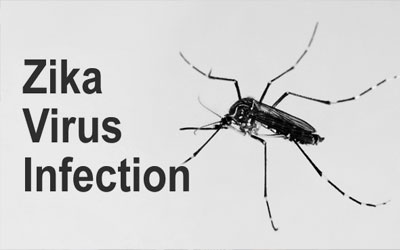 February | Tuesday | 02, 2016 :: Zika virus is related to dengue, yellow fever, Japanese encephalitis, and West Nile viruses. The illness it causes is similar to a mild form of dengue fever, is treated by rest, and cannot yet be prevented by drugs or vaccines. There is a possible link between Zika fever and microcephaly in newborn babies by mother-to-child transmission, as well as a stronger one with neurologic conditions in infected adults, including cases of the Guillain–Barré syndrome.
February | Tuesday | 02, 2016 :: Zika virus is related to dengue, yellow fever, Japanese encephalitis, and West Nile viruses. The illness it causes is similar to a mild form of dengue fever, is treated by rest, and cannot yet be prevented by drugs or vaccines. There is a possible link between Zika fever and microcephaly in newborn babies by mother-to-child transmission, as well as a stronger one with neurologic conditions in infected adults, including cases of the Guillain–Barré syndrome.
In January 2016, the U.S. Centers for Disease Control and Prevention (CDC) issued travel guidance on affected countries, including the use of enhanced precautions, and guidelines for pregnant women including considering postponing travel. Other governments or health agencies soon issued similar travel warnings, while Colombia, the Dominican Republic, Ecuador, El Salvador, and Jamaica advised women to postpone getting pregnant until more is known about the risks.
Along with other viruses in this family, Zika virus is enveloped and icosahedral and has a nonsegmented, single-stranded, positive-sense RNA genome. It is most closely related to the Spondweni virus and is one of the two viruses in the Spondweni virus clade.
The virus was first isolated in April 1947 from a rhesus macaque monkey that had been placed in a cage in the Zika Forest of Uganda, near Lake Victoria, by the scientists of the Yellow Fever Research Institute. A second isolation from the mosquito A. africanus followed at the same site in January 1948. When the monkey developed a fever, researchers isolated from its serum a transmissible agent that was first described as Zika virus in 1952. In 1968, it was isolated for the first time from humans in Nigeria. From 1951 through 1981, evidence of human infection was reported from other African countries such as the Central African Republic, Egypt, Gabon, Sierra Leone, Tanzania, and Uganda, as well as in parts of Asia including India, Indonesia, Malaysia, the Philippines, Thailand, and Vietnam.
There are two lineages of Zika virus, the African lineage and the Asian lineage. Phylogenetic studies indicate that the virus spreading in the Americas is most closely related to the Asian strain, which circulated in French Polynesia during the 2013 outbreak. Complete genome sequences of Zika viruses have been published. Recent preliminary findings from sequences in the public domain uncovered a possible change in nonstructural protein 1 codon usage that may increase the viral replication rate in humans.


